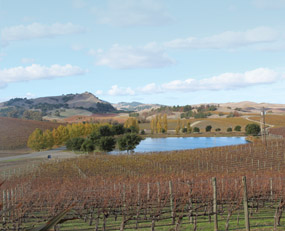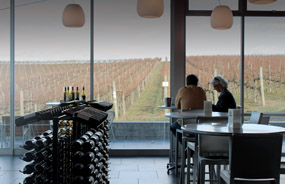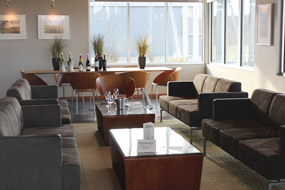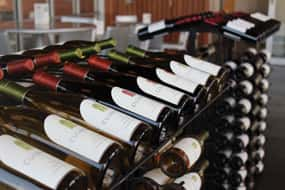 At a Glance
At a GlanceCuvaison Estate Wines
1221 Duhig Rd.
Napa, CA 94559
(707) 942-2455
Hours: 10 a.m. to 5 p.m. daily
Fees: $20
Wines offered: Chardonnay, Pinot Noir, Syrah, Sauvignon Blanc, Zinfandel, Cabernet Sauvignon
Reservations: Required
Picnics: No
Pets: Dog friendly
Did You Know?
“Cuvaison” is the French term for the period of time during alcoholic fermentation when wine is in contact with the solid matter—such as skin, pips and stalks—to extract color, flavor and tannin.
Not sure if you’re in the mood for silky Pinot Noir and Chardonnay or robust mountain reds? How about something in between? No worries, Cuvaison has you covered. With two distinctly different Napa Valley locations (we visited the Carneros estate; see the website for details on the Calistoga location on Silverado Trail), the winery offers both convenience and individual attention.
Cuvaison’s estate vineyard, in the Carneros region of Napa Valley, is 400 acres of rolling hills along San Pablo Bay. There are 240 acres planted to predominantly Chardonnay and Pinot Noir, as well as a smaller amount of Syrah and Sauvignon Blanc. Its onsite, solar-powered winery was completed in 2004, and its sleek, modern tasting room opened its doors in 2009. All Cuvaison wines are grown on the certified Napa Green Land and Winery programs.
 The tasting room itself is unique in that it’s set up as a sit-down, intimate experience. Depending on what you’re looking for, you can enjoy either a simple tasting in the room (or on its expansive deck, which has beautiful views of the vineyards and the valley below—you also can take in the view from inside through the expansive windows that, on warm days, open to let the outdoors in) or you can schedule a tour (they take place at 9:30 a.m. Fridays through Mondays, April through October, and require 24-hour advance notice), where you’ll step into the vineyards and learn about them in detail. On a clear day and from the estate’s highest point, you can see all the way across San Francisco Bay to the City (binoculars are recommended; you also can see Mt. Tam and even Mt. Diablo). Tastings include four wines, which vary by season; you’ll also learn about the winery, its history and the surrounding area at a level that best suits your interests. Ask the right questions and you’ll learn all sorts of interesting things. The Brandlin gallery (there’s all sorts of artwork throughout the tasting areas) is an ideal spot for private tastings and wine and cheese pairings.
The tasting room itself is unique in that it’s set up as a sit-down, intimate experience. Depending on what you’re looking for, you can enjoy either a simple tasting in the room (or on its expansive deck, which has beautiful views of the vineyards and the valley below—you also can take in the view from inside through the expansive windows that, on warm days, open to let the outdoors in) or you can schedule a tour (they take place at 9:30 a.m. Fridays through Mondays, April through October, and require 24-hour advance notice), where you’ll step into the vineyards and learn about them in detail. On a clear day and from the estate’s highest point, you can see all the way across San Francisco Bay to the City (binoculars are recommended; you also can see Mt. Tam and even Mt. Diablo). Tastings include four wines, which vary by season; you’ll also learn about the winery, its history and the surrounding area at a level that best suits your interests. Ask the right questions and you’ll learn all sorts of interesting things. The Brandlin gallery (there’s all sorts of artwork throughout the tasting areas) is an ideal spot for private tastings and wine and cheese pairings.
The estate was established in 1969 and, in 1979, was purchased by its current owners, the Schmidheiny family of Switzerland. The family planted the vineyard in 1980 but phylloxera was discovered in the late 1980s, which required replanting that started in 1991 and was completed 13 years later. The estate and vineyard are locally managed by a team headed by Jay Schuppert (president) and Steve Rogstad (winemaker).
Because of its size and varied terrain, the vineyard is farmed in small blocks that vary in row direction, spacing, trellising and training. This means they’re all farmed uniquely according to what best works for the variety and location. Rogstad oversees the entire vineyard and was also fortunate enough to help design the state-of-the-art winery. He included an extensive fermentation program where he tries out different types of barrels, and concrete and stainless steel fermenters.
In 1998, Cuvaison purchased the historic Brandlin vineyard on Mt. Veeder. The Brandlin family first moved to Mt. Veeder from Switzerland in the 1870s, and the vineyard was originally planted in 1926 by Henry Brandlin. It was later tended by his son, Chester, who lived and farmed there with his brother, Richard. Chester continued to live on the property until passing in February 2013. Ten acres of the original Zinfandel planted there is still on the property, which has plantings ranging from 900 to 1,200 feet in elevation. The newer vineyards, planted by Cuvaison, consist of mostly Cabernet Sauvignon, with traditional Bordeaux blending varieties of Cabernet Franc, Malbec and Petit Verdot. The wine from this estate is labeled under the Brandlin name as a nod to its history and the family who farmed it for so many years.
 When we visited, we first tasted the 2012 Cuvaison Estate Chardonnay, which is the most widely available offering. Crafted from 44 different bocks on the estate, this crisp offering features stone fruit and just a hint of butter with great acidity. Next was the 2012 Kite Tail Chardonnay, which is made from a single block on high ground that’s planted with the Wente clone. It goes through malolactic fermentation and the result is a silky, well-balanced wine with vanilla and crème brulée elements. The 2012 Estate Pinot Noir is an elegant ride with red and black plum flavors and hints of cherry and allspice on the nose. The 2012 Spire Pinot Noir is from the block viewable just outside the east-facing window of the tasting room (the top is the highest point on the estate) and is a smooth, well-rounded and balanced wine with a hint of spice.
When we visited, we first tasted the 2012 Cuvaison Estate Chardonnay, which is the most widely available offering. Crafted from 44 different bocks on the estate, this crisp offering features stone fruit and just a hint of butter with great acidity. Next was the 2012 Kite Tail Chardonnay, which is made from a single block on high ground that’s planted with the Wente clone. It goes through malolactic fermentation and the result is a silky, well-balanced wine with vanilla and crème brulée elements. The 2012 Estate Pinot Noir is an elegant ride with red and black plum flavors and hints of cherry and allspice on the nose. The 2012 Spire Pinot Noir is from the block viewable just outside the east-facing window of the tasting room (the top is the highest point on the estate) and is a smooth, well-rounded and balanced wine with a hint of spice.From the Brandlin vineyard, we sampled the 2011 Estate Cabernet Sauvignon (earthy, masculine with dark fruit and a strong structure). Since the vineyard’s fruit is thick-skinned due to its cool temperatures and high elevation, Rogstad crafts it by incorporating air into the wine to help it become more lush and develop better tannin structures (the results are outstanding). We also tried the 2011 Henry’s Keep, a proprietary red blend made with Cabernet Sauvignon, Malbec, Cabernet Franc and Petit Verdot. Its name is in homage to when Henry Brandlin kept the best barrels for his family, and the result is a super complex, lush wine with dark fruit, a strong backbone and a classic Mt. Veeder profile. We enjoyed every one of these wines, along with the view, to the ultimate last drop.



